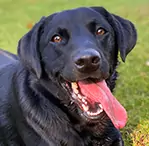
Meet the Labrador Retriever
Pawfect Playmate
Best Fur Friend
High Doggy I.Q.
My Many Looks
My Breed Characteristics
Furbulous Fact
As I Grow Up
History of My Breed
Care Tips
Training Tips
Personality
Smart
Loving
Playful
Group
Sporting Group
Origin
Newfoundland
Life Span
10-12 Years
Breed Popularity
#1 of 195
Height Range
21.5-24.5 Inches
Weight Range
55-80 Pounds
Coat Details
Type
Short
Texture
Straight
Features
Weather Resistant
Colors
Black, Chocolate, Yellow, +/- White Markings
Hypoallergenic
Cost to Buy
$400-$1,500
Lifetime Care Cost
$21,890
My Many Looks
My Breed Characteristics
Furbulous Fact
As I Grow Up



History of My Breed
Care Tips
from Dr. Jessica Greenberg, Associate VeterinarianHelp your Lab avoid obesity.
Labrador Retrievers are prone to obesity, which also predisposes them to joint problems or arthritis. Speak to your vet about appropriate diet and exercise plans to keep your Lab healthy and energized!
Watch for signs of bloat.
As a larger breed dog, Labs are at a greater risk of suffering from bloat (GDV). This happens when the stomach fills with air causing pressure to build, which stops blood from returning to the heart. If the stomach flips, it deprives the pancreas of oxygen which then produces harmful toxins. Talk to your vet about gastropexy, which can largely prevent this from happening.
Maintain your Lab’s ears.
Labs are known to have frequent ear infections, more often than other breeds. Be alert from the start and regularly check your dog’s ears for infection and clean them as needed.
Training Tips
from Dr. Jessica Greenberg, Associate VeterinarianDon’t train your puppy to jump on people.
Sometimes, owners inadvertently train their Labs to jump on people. When they’re puppies, it’s cute, but it’s different when they’re suddenly big dogs with muddy paws! When your Labrador puppy jumps on you, ignore them entirely and turn your back to them. After they calm down, you can continue what you were doing before.
Train them out of excessive barking.
Labrador Retrievers tend to bark a lot. Ignore your dog when they’re barking at you. If they bark while you’re in the middle of playtime, calmly end playtime and reinforce the idea that barking never gets them anything they want. If you pet them when they bark, that’s positive feedback and they will continue to do it. You have to just ignore them.
Be cautious of your Lab getting too attached to you.
Labs often have separation anxiety so train them to be comfortable on their own when you’re not around. If they’re around one person all the time, shift primary care to another member of the household. Ignore them if they’re hovering around you for excessive periods of time. This doesn’t mean you can’t bond or cuddle with your puppy, just don’t do it 24/7. Otherwise, you’ll have a dog that will whine and become very anxious when you’re not around. For the dog’s mental state, allow for healthy distance between you two.
My Many Looks
My Breed Characteristics
Furbulous Fact
As I Grow Up
History of My Breed
Care Tips
Training Tips
-
Personality
Smart
Loving
Playful
-
Group
Sporting Group
-
Origin
Newfoundland
-
Life Span
10-12 Years
-
Breed Popularity
#1 of 195
-
Height Range
21.5-24.5 Inches
-
Weight Range
55-80 Pounds
-
动物皮毛
Type
Short
Texture
Straight
Features
Weather Resistant
Colors
Black, Chocolate, Yellow, +/- White Markings
-
Hypoallergenic
-
Cost to Buy
$400-$1,500
-
Lifetime Care Cost
$21,890


